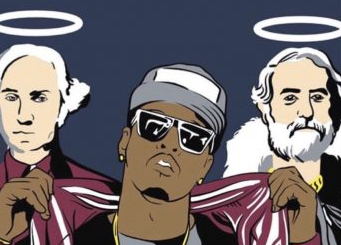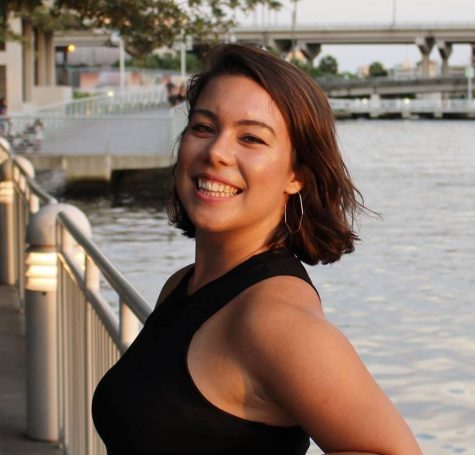The complications of student advertising that features black music artists
When pop culture meets a dialogue about inclusion

October 21, 2019
Kappa Kappa Gamma’s rush shirts this year display a drawing of Chance the Rapper with the caption, “Take a chance on Kappa.”
The Traveller shirts feature Lil Nas X as a bus driver, with lyrics from his hit song, “Old Town Road.”
Delta Society’s rush shirts from last year featured Kanye West’s album cover for “ye,”with the caption, “I love being a Delta it’s awesome.”
And Mock Convention advertised for its state delegations with Lizzo’s “Truth Hurts” lyrics.
(The reporter is a member of the Mock Convention communications team, although she was not involved in the advertising.)
There’s a growing trend of student organizations at Washington and Lee using black music artists as part of their advertising. For some, it’s about the pop culture appeal. But for others, especially some black students, who make up just 3 percent of the student body, the messaging can carry a deeper meaning about inclusion on a campus like Washington and Lee.
Tahri Phillips, ‘23, asked a room full of students during a Student Association for Black Unity meeting on Tuesday, Oct. 8 if any of the people involved in making the t-shirts in question were present. No one said they were.
“The same people that are taking from us, they’re not actually showing up,” Phillips said. “They’re content to take what they want from us and call it a day. … For them, it’s most times not done maliciously. It’s just, they don’t know.”
Phillips said she didn’t find the Lizzo and Lil Nas X lyrics to be problematic. But, for her, the distinction is when the image of the black artist is part of the advertisement.
“We’re all singing Lizzo,” Phillips said. “We can all appreciate that music. But when you monetize it, you’re making money off a black person’s face.”
The issue made waves in March when the Generals Activities Board advertised for the upcoming Jeremih concert with the black hip-hop artist’s skin color appearing the same shade of white as George Washington and Robert E. Lee. Washington and Lee both had halos over their heads in imitation of the “MihTy” album cover.


Anjeli Hoskins, ‘22, said when her mother saw the Jeremih concert marketing, she asked why there were halos above Washington and Lee’s heads. “The way they portray them makes them seem like angels,” she said her mom said at the time.
“Black culture is pop culture now and I don’t know how much we can get away from appropriation,” Hoskins said.
Maddie Geno, ‘20, had concern about last year’s GAB design for the Jeremih concert, as well.
“You can’t make Jeremih white if he’s black,” Geno said. “That’s just wrong.”
Geno, who is the current president of Delta Society, said no one had approached the organization with feedback about last year’s rush t-shirts.
“A lot of people listen to Kanye West,” she said. “Our rush shirt [this year] is camo and doesn’t say anything about us as a group. People want to wear shirts that are trendy and catchy.”
Geno said she remembered the organization (formerly Kappa Delta) had rush shirts three years ago with the words, “Straight Outta Kappa Delta,” after the 2015 movie Straight Outta Compton. She said the sorority president eventually told members they could no longer wear the t-shirts after she said they received pushback from the university.
“I’m sure the people in Kappa Delta my freshman year didn’t want anyone to make connections between them and Compton and police brutality,” she said. “There is this thread of a lack of deeper thinking about the messages behind these things.”
Griffin Noe, ‘21, who is on the Traveller Steering Committee, said in an email that the committee chose Lil Nas X’s “Old Town Road” for its t-shirt given out to first-year students because of the song’s popularity and travel references.
“The drawing of Lil Nas X was produced by University Tees, and we had little to do with the specifics of the drawing,” Noe said. “The shirt did go through an approval process by the Steering Committee before the order was placed. The design was chosen because of its relatability to Traveller activities and its success on U.S. charts.”
Some have said the Kappa shirt portrays Chance the Rapper’s skin as darker than it is. After a student reached out to the sorority with concern over the t-shirt, Kappa members stopped wearing it. The Kappa president said she will meet with the student and a university administrative assistant for a conversation on Wednesday, Oct. 23.
The Kappa president declined to comment on the record before she had the conversation.
The president said the two Kappa rush chairs had sent their idea for the design to an external t-shirt company, with the image of Chance the Rapper’s “Coloring Book” album cover and the caption, “Take a chance on Kappa.” Kappa’s chapter, the national organization, Washington and Lee’s Panhellenic Council, and a university staff member approved the t-shirt design, but the president said she didn’t see the design before the t-shirts were printed.
“One of the main problems is there’s not a dialogue,” Hoskins said, adding that some non-black students may think SABU is an exclusive organization for only black students, even though it is open to the whole student body.
Leia Barrow, ‘22, who is SABU’s vice president, said one of the missions of the organization is to educate, and that ignorance can’t be an excuse.
“They don’t understand the sensitivity of that on their shirt,” Barrow said. “It was white women who got black men hung because they lied on them. They don’t understand the historical context of why we react when we see things like that because they refuse to acknowledge that part of history that their ancestors caused.”
Geno said she thought this issue would be good for discussion during the university’s Office of Inclusion and Engagement (OIE) meetings, especially now that the office has sorority representatives.
She said she wasn’t aware Delta Society could join until the OIE Day event in Commons Living Room on Wednesday, Oct. 16, and she appointed two representatives from the sorority that day.
“I don’t know who the chair of SABU is and I think the same goes for them. I don’t know if they would know how to go about contacting me,” she said. “I think there’s a lack of communication with GAB and sororities and Traveller, and the groups that may have had a problem with the t-shirts.”
Avalon Pernell, ‘23, said she thought the decision-making process behind the t-shirts boils down to an issue of lack of diverse representation.
“Especially in those organizations where there are very few people of color, it shouldn’t have to come down to one person making the decision,” she said.
Amber Morrison, ‘23, said she feels like the perspective of black students wasn’t considered when the t-shirt designs were made.
“They will take our culture and use it for their own means,” Morrison said, “but then will still say ‘build that wall’ or support prison laws that marginalize our people.”
Geno said she felt that students have the right to voice their concern about things on campus they find offensive.
“I don’t think pop culture is off limits,” she said. “I think it falls on people to just be mindful about what they put out there.”
Kam Godsey, ‘23, said that when she’s asked about things like the “Big Fiesta” fraternity party theme, she’s been told that a person of color within the organization signed off on it. But she said it’s not enough representation for the whole community.
“The [administration] wants us to be here,” she said. “But does the student body want us to be here? Do they want us to feel included and appreciated?”




POC • Oct 23, 2019 at 4:24 pm
So what does Big Fiesta have to do with black music artists?
Also, POC is offensive to Mexicans- please be more culturally sensitive next time.